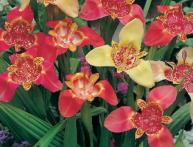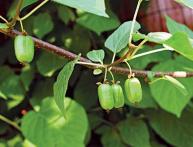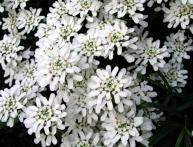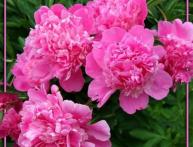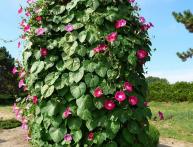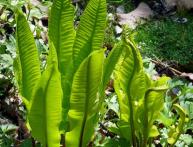Golden ball flowers: beauty in simplicity
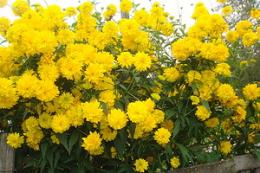
Amazing yellow double flowers can be found in the front gardens of country houses, in flower beds in populated areas, some plants are of very ordinary height, 70 - 80 cm in height, and some - real giants, rise above the ground by more than two meters.
The flowers got their name from the appearance of the inflorescences. In the scientific world they are called rudbeckia dissecta.
Content:
Botanical description
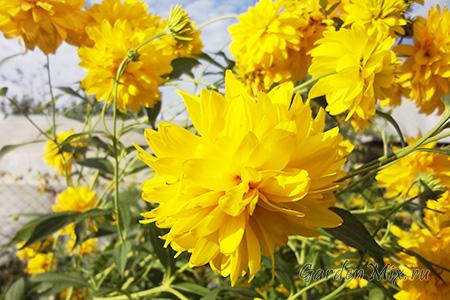
The seeds of bright yellow flowers came to Europe directly from the forests and prairies of North and South America. When botanical material came from the hands of the discoverers of America to the founder of plant taxonomy, Carl Linnaeus, he named a new genus of bright flowering plants in honor of two of his colleagues and teachers: W. Rudbeck Sr. and W. Rudbeck Jr., father and son.
The genus Rudbeckia is represented by several species of annual and perennial plants:
- rudbeckia pilosa
- rudbeckia brillianti
- rudbeckia glossy
- Rudbeckia dissecta
All these wild species were used in breeding work to create new varieties and hybrids. It is on the basis of dissected rudbeckia that one of the most famous and popular varieties, “Golden Ball,” was obtained.
The Golden Ball refers to perennial herbaceous plants. The plant reaches a height of 2 to 2.5 meters. The leaves are green, strongly dissected.
Bright inflorescences - baskets consist of two types of flowers:
- reed located on the edge
- tubular, located in the middle
Reed flowers have a bright yellow color of various shades. The flowers are double, usually well filled, spherical; for their shape and color, the variety was called “Goldball” - golden ball.
The variety gained its popularity thanks to its long flowering, which begins in early July and continues almost until frost. In addition, the golden balls are practically not damaged by pests and are not susceptible to disease.
However, they have two significant drawbacks:
- Tall shoots “fall apart” in different directions, giving the flowerbed an unkempt appearance.
- The plant tends to grow aggressively, occupying the entire area of the flower garden.
To eliminate the first drawback, a low-growing variety "Goldguelle" was bred - a golden source, the height of the shoots of which does not exceed 80 - 90 cm. The variety has golden double flowers, which delight the eye with abundant flowering almost all summer and autumn.
It is convenient to plant dissected rudbeckia where there is no need for annual renewal of the assortment of perennial flowers. In addition, the growing powerful rhizomes can quickly fill any area, leaving no chance for weeds.
Reproduction, planting, care
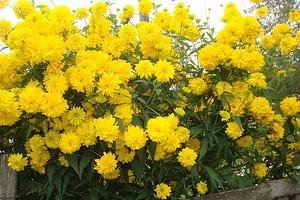
Reproduction
Rudbeckia golden balls reproduces both by seeds and vegetative parts.
To grow golden balls from seeds, you can sow them for seedlings at home at the end of March - beginning of April, and at the end of May replant young plants for a permanent place in the garden.
For sowing, it is necessary to fill the seedling containers with a mixture of garden soil with sand and humus. Plant the seeds into the soil to a depth of 3 mm. After 10 - 12 days, shoots will appear.
Caring for seedlings consists of regular watering and observing the lighting regime; when the temperature outside is not lower than +15 + 18 degrees, the seedlings can be taken out into the open air for hardening. It is allowed to sow rudbeckia immediately in a permanent place, or propagate it by dividing the bush.
Landing
When choosing a place to plant golden ball flowers, you should opt for a well-lit place; rudbeckia grows well in light shade.
There are no special requirements for the composition of the soil, but before planting it is necessary:
- dig the ground to the depth of a spade bayonet
- thoroughly remove any remaining weeds
- add humus or compost at the rate of 5 - 6 kg per square meter
- apply mineral complex fertilizers
In the prepared soil, at a distance of 30 cm - 50 cm, make holes where to place young seedlings obtained from seedlings or a part of a plant separated from the mother bush. Water the plantings well. Before rooting seedlings water regularly.
Care
During the season, it is advisable to fertilize golden balls twice, the first time in May, before flowering begins, the second time at the end of August, before the onset of autumn. Any complex fertilizer will do, such as Kemira or Agricola for flowers.
Once every 4 - 5 years it is necessary to thin out the plantings and, if possible, divide old bushes and remove excess growth. During flowering, tall golden balls need a garter to a vertical support, otherwise the bushes will not withstand the weight of many inflorescences.
Although rudbeckia is a drought-resistant plant and tolerates heat well, without additional watering in hot seasons it produces fewer flowers and loses its decorative appearance.Before the start of the cold season, ground stems of flowers should be completely cut off almost just above the ground, leaving no more than 10 cm.
Diseases and pests do not cause significant harm to golden balls. It is worth saying that no matter what new items the breeders give to flower growers, golden ball flowers will invariably grow in gardens and flower beds, prolonging the summer with their sunny inflorescences.
Flowers golden ball
Interesting information about the vegetable garden



